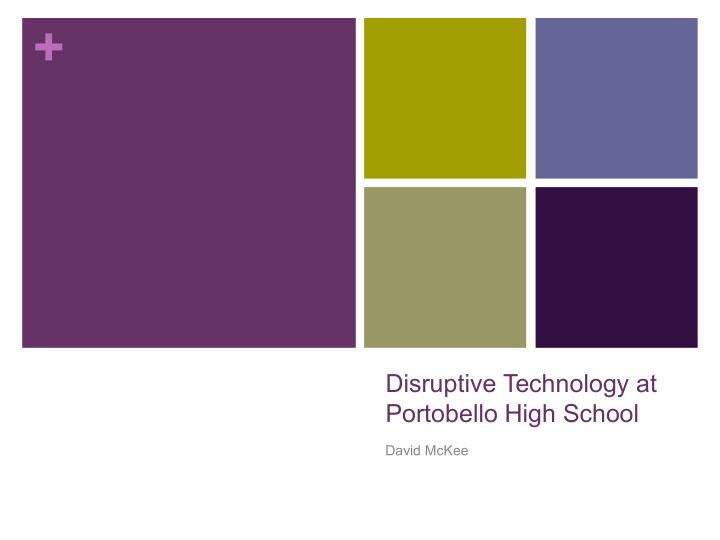



+ Disruptive Technology at Portobello High School David McKee
+ What is ‘disruptive technology’? “A disruptive technology is a technological innovation, product, or service that eventually overturns the existing dominant technology or product in the market .” “New ways of doing things that disrupt or overturn the traditional business methods and practices. For example, steam engine in the age of sail, and internet in the age of post office mail .”
+ Disruptive technology at Edinburgh University Graduate architecture students, part 2 of professional programme studying Disruptive Technology unit Remo Pedreschi and Chris Speed: Material (concrete) + Immaterial (digital) Apparently discrete, but connected by the idea of ‘hacking’ and considering how something is used, possibly not as intended Digital – new technologies, pervasiveness of networks Concrete – new techniques for casting Both now easier to do, disrupting who can make it and what can be made
+ How did we get involved? Project ongoing at Castleview Primary School Kenny MacAskill MSP recommended talking to us Working towards new school Interesting context for students to consider – what is a school? Remo Pedreschi, Professor of Architectural Technology John Burnside, previous Depute Just completed 2 nd group in May
+ Approach: ‘user -centred innovation’ Eric Von Hippel: Democratizing Innovation - ‘manufacturers should systematically seek our innovations developed by users’ Work with school (‘lead user’) to establish need and to develop idea – grass roots rather than top down In practice, each student works with a teacher and a group of pupils Students have an area of interest (and research/context eg CfE) but develop their ideas through discussion and decide what the project will be Outcomes unpredictable, and potentially disruptive, process as important as output Different way for students to think about how to approach projects
+ Example
+ Example
+ Example
+ Teacher feedback “ John has been great. We have been team teaching together and he has been flexible in manipulating the tasks or experiments to fit the needs of the pupils. We tested how well pupils learn using mobile phones compared to teacher led learning. We also tested how photographs could be used to develop a pupil's perspective on events. For this, a pupil dressed up as a World War 1 soldier and we took photos of them in a makeshift No man's land. The pupils loved it and gleaned how a man could be powerful/fragile, nervous/ courageous at the same time from the photographs from different angles. John has spoken to the class on a number of occasions to explain his vision and provided the pupils with feedback on how these experiments went. It has been a lot of fun.” “It was both useful and interesting – with Barnaby's project, the Eco Team got data out of it, a way of linking their work with the 'real world' and insight into the implications their work will have globally, e.g. paper use and forest destruction”. “It was a rather ethereal concept”
+ Benefits to the school ‘Nice to have some contact with the real world !’ Pupils and teachers experience rich engagement with partners, innovative and unusual projects - active learning, novel topics, student-centered approaches Challenge existing thinking and processes – do things differently? Still improving, but definitely a worthwhile project for the school
Recommend
More recommend